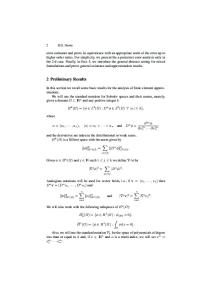Finite Element Introduction
In this chapter we introduce the topic of finite element analysis for beam vibration. In Chap. 8 we described continuous models based on Euler-Bernoulli beam theory. This is a reasonable approach for a simple geometry, such as the cylindrical shaft in a
- PDF / 15,472,978 Bytes
- 439 Pages / 439.42 x 683.15 pts Page_size
- 9 Downloads / 472 Views
chanical Vibrations Modeling and Measurement Second Edition
Mechanical Vibrations
Tony L. Schmitz • K. Scott Smith
Mechanical Vibrations Modeling and Measurement Second Edition
Tony L. Schmitz Mechanical, Aerospace, and Biomedical Engineering University of Tennessee, Knoxville Knoxville, TN, USA
K. Scott Smith Manufacturing Demonstration Facility Machining and Machine Tools Research Group Oak Ridge National Laboratory Knoxville, TN, USA
ISBN 978-3-030-52343-5 ISBN 978-3-030-52344-2 https://doi.org/10.1007/978-3-030-52344-2
(eBook)
© Springer Nature Switzerland AG 2012, 2021 This work is subject to copyright. All rights are reserved by the Publisher, whether the whole or part of the material is concerned, specifically the rights of translation, reprinting, reuse of illustrations, recitation, broadcasting, reproduction on microfilms or in any other physical way, and transmission or information storage and retrieval, electronic adaptation, computer software, or by similar or dissimilar methodology now known or hereafter developed. The use of general descriptive names, registered names, trademarks, service marks, etc. in this publication does not imply, even in the absence of a specific statement, that such names are exempt from the relevant protective laws and regulations and therefore free for general use. The publisher, the authors, and the editors are safe to assume that the advice and information in this book are believed to be true and accurate at the date of publication. Neither the publisher nor the authors or the editors give a warranty, expressed or implied, with respect to the material contained herein or for any errors or omissions that may have been made. The publisher remains neutral with regard to jurisdictional claims in published maps and institutional affiliations. This Springer imprint is published by the registered company Springer Nature Switzerland AG The registered company address is: Gewerbestrasse 11, 6330 Cham, Switzerland
To our children, Jake, BK, Kellye, and Kyle
Preface
In this second edition textbook, we describe essential concepts in the vibration analysis of mechanical systems. The book incorporates the fundamentals of modal analysis, beam theory, and finite element analysis, as well as the required mathematics and experimental techniques, into a unified framework that is written to be accessible to undergraduate students, researchers, and practicing engineers alike. This book is based on undergraduate courses in mechanical vibrations that we have previously offered and developed the text to be applied in a traditional 15-week course format. It is appropriate for undergraduate engineering students who have completed the basic courses in mathematics (through differential equations) and physics and the introductory mechanical engineering courses including statics, dynamics, and mechanics of materials. We organized the book into ten chapters. The chapter topics are summarized here. • Chapter 1—We introduce the types of mechanical vibrations, damping, and periodic motion. • Chapter
Data Loading...











